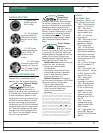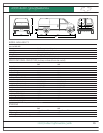
1998 Astro
8 1998 Product Information Guide
Vortec 4300 V6 Engine (L35)
A Vortec 4300 V6 engine with Sequential
Fuel Injection (SFI) is standard on Astro. This
refined V6 is one of the most advanced
engines in its class. It provides:
• 190 horsepower at 4400 rpm
• 250 lb.-ft. of torque at 2800 rpm.
Extended-Life Service Items Include:
• Platinum-tip spark plugs for extended
service intervals*
• No need to check engine timing — ever
• Extended-life coolant good for as long as
5 years or 150,000 miles, whichever comes
first*
• Single accessory drive belt helps reduce
replacement costs compared to traditional
belt designs.
*Maintenance needs vary with different uses and driving
conditions. See owner’s manual for more information.
ON-BOARD DIAGNOSTICS
SECOND GENERATION (OBD II)
On-Board Diagnostics for Astro is
highly sophisticated, thanks to OBD II
(On-Board Diagnostics Second Generation),
a 1996 federal mandate.
• The system can mean faster, repairs for
consumers. Take better engine diagnosis,
for example. In low-level engine misfire,
bad fuel, improper maintenance, cracked
sparkplug insulation or plugged fuel injec-
tors can all lead to a misfire diagnosis
that’s picked up by OBD II.
• OBD II functions by using a Vehicle
Control Module (VCM) to monitor fuel
delivery, ignition timing and the emissions
system to detect deterioration or
malfunction.
• If a problem is detected, a Diagnostic
Trouble Code (DTC) is stored and indicates
the type of fault detected.
• The VCM stores and retrieves diagnostic
messages to help technicians fix problems
quickly and accurately.
• The VCM alerts the driver by illuminating
the “Service Engine Soon” light when it
detects a deterioration in the performance
of any of the monitored components.
• Unlike first-generation systems that
signaled only system failures, OBD II
alerts the driver to have the vehicle
serviced before experiencing a possible
breakdown or incurring more expensive
repairs.
SEQUENTIAL FUEL
INJECTION (SFI)
Sequential Fuel Injection, standard on
all 1998 Astro models, is a far cry from yester-
day’s fuel-control systems, such as Electronic
Fuel Injection or Multi-Port Fuel Injection. SFI
optimizes fuel economy, power output and
the ability to meet today’s stringent emissions
control requirements.
• SFI’s secret is its high precision fuel control
which uses one injector and nozzle per
cylinder for optimum cylinder-to-cylinder
fuel distribution.
• Each injector is fired sequentially and
timed to the intake cycle for accuracy and
metering control. (With non-SFI engines,
fuel is typically injected twice per cycle or
once per crankshaft revolution through all
injectors at the same time. With SFI, the
timing is much more precise, leading to
performance improvements across the
board.)
SEQUENTIAL FUEL
Transmission Fluid?
Don’t Give It A Second
Thought
Chevrolet automatic
transmissions like the 4L60-E
are “lubed for life,” thanks to
extended-life transmission
fluid. This fluid should never
need changing under normal
operating conditions since
it features a special additive
that resists oxidation,
provides outstanding friction
characteristics and is
compatible with the wide range
of materials used in today’s
transmissions. Even the change
interval for severe service —
50,000 miles — is three times
that of its predecessor fluid.
Where’d That Jerk Go?
Chevrolet automatic
transmissions like the
4L60-E provide owners with a
smooth driving experience.
There was a time when a
smooth driving experience was
reserved for luxury vehicles
only, and certainly not to be
expected in a van. No longer.
Now, thanks to transmissions
like the 4L60-E, electronic shift
control helps reduce what some
used to call a “somewhat jerky”
operation. The electronic
control makes possible very
smooth shift patterns at all
vehicle speeds.
So, whether the mission is
taking the versatile Astro out
for a family drive, or hauling a
load of heavy thingamajigs
across town, the 4L60-E helps
assure a smooth ride.


















